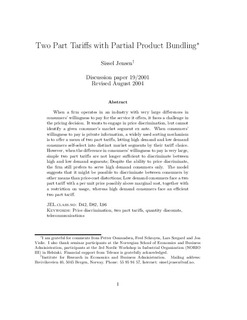Two part tariffs with partial product bundling
Working paper
Permanent lenke
http://hdl.handle.net/11250/162838Utgivelsesdato
2001Metadata
Vis full innførselSamlinger
- Discussion papers (SAM) [657]
Sammendrag
When a firm operates in an industry with very large differences in
consumers' willingness to pay for the service it offers, it faces a challenge in
the pricing decision. It wants to engage in price discrimination, but cannot
identify a given consumer's market segment ex ante. When consumers'
willingness to pay is private information, a widely used sorting mechanism
is to offer a menu of two part tariffs, letting high demand and low demand
consumers self-select into distinct market segments by their tariff choice.
However, when the difference in consumers' willingness to pay is very large,
simple two part tariffs are not longer sufficient to discriminate between
high and low demand segments; Despite the ability to price discriminate,
the firm still prefers to serve high demand consumers only. The model
suggests that it might be possible to discriminate between consumers by
other means than price-cost distortions; Low demand consumers face a two
part tariff with a per unit price possibly above marginal cost, together with
a restriction on usage, whereas high demand consumers face an efficient two part tariff.
Beskrivelse
Updated August 2004
Utgiver
Norwegian School of Economics and Business Administration. Department of EconomicsSerie
Discussion paper2001:19
